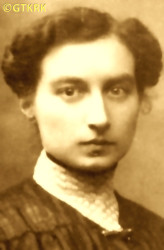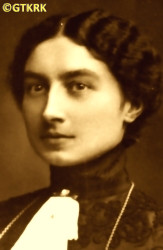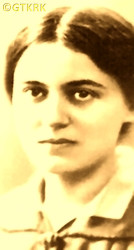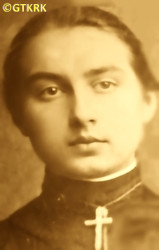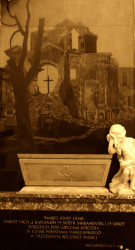Roman Catholic
St Sigismund parish
05-507 Słomczyn
85 Wiślana Str.
Konstancin deanery
Warsaw archdiocese, Poland
full list:
displayClick to display full list

searchClick to search full list by categories
wyświetlKliknij by wyświetlić pełną listę po polsku

szukajKliknij by przeszukać listę wg kategorii po polsku

Martyrology of the clergy — Poland
XX century (1914 – 1989)
personal data
surname
KOPERSKA
forename(s)
Apolonia Eleonor (pl. Apolonia Eleonora)
religious forename(s)
Mary Thomae of the Holy Trinity (pl. Maria Tomea od Trójcy Przenajświętszej)
function
nun
creed
Latin (Roman Catholic) Church RCmore on
en.wikipedia.org
[access: 2014.09.21]
congregation
Congregation of the Benedictine Nuns of the Blessed Sacrament OSBapmore on
www.sites.google.com
[access: 2014.09.21]
(i.e. Benedictine Nuns of Perpetual Adoration)
diocese / province
RC Military Ordinariate of Polandmore on
en.wikipedia.org
[access: 2014.12.20]
academic distinctions
Doctor of Philosophy
date and place
of death
31.08.1944

Warsawtoday: Warsaw city pov., Masovia voiv., Poland
more on
en.wikipedia.org
[access: 2021.10.09]
details of death
After the German and Russian invasion of Poland in 09.1939 and the start of World War II, after the beginning of the German occupation, from c. 1942 clandestinely led lectures — in the field of Catholic psychology, in which criticized the foundations of the ideology of national socialism prevailing in Germany — as part of the Polish clandestine education system ( part of the Polish Clandestine State). Prob. the lectures were part of the activities of the theological faculty of the clandestine University of the Western Lands UZZ, which had been operating in the German‐run General Governorate since 1940, where most of the lecturers came from the University of Poznań, shut down by the Germans, and the students were high school graduates displaced by the Germans from Greater Poland, Pomerania and Silesia.
Perished during Warsaw Uprising that started on 01.08.1944, under the rubble of St Casimir church in Warsaw bombed out by the Germans, along with 36 other nuns and over 1,000 civilians.
The church and its basement were transformed during the Uprising into a field hospital, run by the Medical Office of the Warsaw District of the Home Army AK (part of Polish Clandestine State) codename „Bakcyl”, part of the AK „North” Group (the fighting AK soldiers called her „Sister Thomae” considering it her conspiracy nom‐de‐guerre). The area of the Old Town where they are located had been under siege by the Germans for about two weeks.
On the night of 30‐31.08.1944, the insurgents made an unsuccessful attempt to break through to the Śródmieście district — it was the bloodiest battle during the Uprising. In retaliation, the Germans carried out particularly heavy bombings of the Old Town, including St Casimir church.
Earlier, the nuns rejected the German ultimatum to leave the monastery under the threat of its bombing — took a vow to remain until the end with the people hiding in the basement of the church, treating their possible death as a sacrifice for Poland, their homeland. Those who survived remembered „the image of praying nuns”.
cause of death
shelling (bombardment)
perpetrators
Germans
sites and events
Warsaw (St Casimir church)Click to display the description, Warsaw UprisingClick to display the description, Secret educational systemClick to display the description, GeneralgouvernementClick to display the description, Ribbentrop‐MolotovClick to display the description, Pius XI's encyclicalsClick to display the description
date and place
of birth
14.04.1887Birth certification on:
metryki.genealodzy.pl
[access: 2025.04.13]

Warsawtoday: Warsaw city pov., Masovia voiv., Poland
more on
en.wikipedia.org
[access: 2021.10.09]
parents
KOPERSKI Ignatius
🞲 ?, ? — 🕆 ?, ?

KROSZEWSKA Elisabeth
🞲 ?, ? — 🕆 ?, ?
baptism
30.05.1887Birth certification on:
metryki.genealodzy.pl
[access: 2025.04.13]

Warsawtoday: Warsaw city pov., Masovia voiv., Poland
more on
en.wikipedia.org
[access: 2021.10.09]
St Alexander the Martyr RC church
religious vows
07.03.1931 (temporary)
21.03.1934 (permanent)
positions held
till 1944
deputy superior — Warsawtoday: Warsaw city pov., Masovia voiv., Poland
more on
en.wikipedia.org
[access: 2021.10.09] ⋄ monastery (by the St Casimir church in the New Town at 2 Rynek Nowego Miasta), Benedictine Nuns of Perpetual Adoration OSBap — also: novice mistress
01.03.1930 – 1931
novitiate — Warsawtoday: Warsaw city pov., Masovia voiv., Poland
more on
en.wikipedia.org
[access: 2021.10.09] ⋄ monastery (by the St Casimir church in the New Town at 2 Rynek Nowego Miasta), Benedictine Nuns of Perpetual Adoration OSBap
06.07.1929
accession — Benedictine Nuns of Perpetual Adoration OSBap
Poznańtoday: Poznań city pov., Greater Poland voiv., Poland
more on
en.wikipedia.org
[access: 2021.07.18] — collaborator of St Adalbert's Bookstore and Printing House and the censor of his Publishing House, collaborator of their director, Fr Stanislav Adamski (in 1919‐1922 a member of the Polish Legislative Parliament, 1922‐1927 a senator, from 1930 an Ordinary Bishop of Katowice); also: lecturer at the Historical and Literary Faculty of the Friends of Sciences Society in Poznań
till 1913
PhD student — Fribourgtoday: Fribourg can., Switzerland
more on
en.wikipedia.org
[access: 2021.07.25] ⋄ Department of Philosophy, Lat. Universitas Friburgensis (Eng. University of Fribourg) — PhD thesis Germ. „Die Stellung der religiösen Orden zu den Profanwissenschaften im 12 und 13 Jahrhundert” (Eng. „The position of the religious orders towards the secular sciences in the 12 and 13 centuries”), public defense in 1913, ed. Freiburg, 1914
1904 – 1915
nun — clandestine Institute of the Servants of the Sacred Heart of Jesus — Messengers of Mary (Servant Sisters ISNSJPM)
author of several books, brochures and articles, including „Biography of St Benedict, Patriarch of Monastic Life in the West” (Poznań, 1934), „Christ and Education” (Kraków 1927), „The Social Duty of Catholics in the Modern Era” (in: „Gość Niedzielny”, 1923‐1925), „Principles of Christian Politics” (Poznań, 1921), „Woman–Citizen” (in: „Przewodnik Społeczny”, 1920), „Dominican Fathers and Their Outposts in the Archdiocese of Warsaw” (in: „Wiadomości Archidyecezyalne Warszawskie”, 1918); translator of, among others, the book „Initiation into the Philosophy of St Thomas Aquinas” by Fr Emil Paillaube OP (published in Poznań 1930)
others related
in death
BAREJKAClick to display biography Catherine (Sr Mary Gertrude of the Holiest Heart of Jesus), BORKEMClick to display biography Louise (Sr Mary Antonina of the Holy Ghost), KARCZClick to display biography Hedwig Magdalene (Sr Mary Joachima of the Blessed Sacrament), KARCZEWSKAClick to display biography Sophia (Sr Mary Rose of the Blessed Sacrament), KILAŃSKAClick to display biography Catherine (Sr Mary Benita of the Holiest Heart of Jesus), KOWALSKAClick to display biography Victoria (Sr Mary Anne of the St Joseph's Protection), KRAKÓWClick to display biography Irene (Sr Hillary), KUŹMIŃSKAClick to display biography Margaret (Sr Mary Catherine of the All Saints), MARCZUKClick to display biography Helen (Sr Mary Bernarda of the Holiest Family), MATUSZCZAKClick to display biography Mary (Sr Mary Anselma of Immaculate Conception of the Blessed Virgin Mary), MIĘTKOWSKAClick to display biography Mary (Sr Mary Cecilia of the Blessed Sacrament), NARUKClick to display biography Mary (Sr Mary Elisabeth of the Mother of God), OLĘDZKAClick to display biography Janet (Sr Mary Josefa of Immaculate Conception of the Blessed Virgin Mary), PIOTROWSKAClick to display biography Antonina (Sr Mary Casimira of the Holiest Heart of Jesus), POGONOWSKAClick to display biography Irene Casimira (Sr Mary Vladislava of the Holiest Wounds of the Lord Jesus), POLAKOWSKAClick to display biography Marianne (Sr Mary Flavia of the Cross), PRZEMYSKAClick to display biography Angela (Sr Mary Stanislava of Divine Mercy), PRZYKOPClick to display biography Janet, PUCHAŁAClick to display biography Genevieve (Sr Mary Hedwig of the Blessed Sacrament), REJEWSKAClick to display biography Stephanie Wanda (Sr Mary Ignatia of the Lamb of God), RUDNICKAClick to display biography Caroline (Sr Mary Clementine of the Holiest Heart of Jesus), SCHMITZ de GROLLENBOURGClick to display biography Mary Josefa (Sr Mary Magdalene of the St Joseph's Protection), SIWEKClick to display biography Francesca (Sr Barbara), SŁOWACKAClick to display biography Sophia Catherine (Sr Mary Andrea of the Nativity of the Blessed Virgin Mary), SUMIŃSKAClick to display biography Bogumila (Sr Mary Colomba of the Holiest Heart of Jesus), SZKIŁĄDŹClick to display biography Casimira (Sr Mary Modeste of the Cross), TOKARSKAClick to display biography Janet Bronislava (Sr Mary Agnes of Jesus), TOMASZEWSKAClick to display biography Aurelia (Sr Mary Therese of Jesus), TRYCClick to display biography Josefa (Sr Mary Aloysia of St Benedict), TURAKClick to display biography Rosalie (Sr Mary Ceslava of the St Joseph's Protection), ZALAZEKClick to display biography Josefa Marianne (Sr Mary Margaret of the Holiest Heart of Jesus), ZALEWSKAClick to display biography Laurence Laurentia (Sr Mary Augustina of the Blessed Sacrament), ZAŁUSKAClick to display biography Sophia Apolonia (Sr Mary Innocente of the Cross), ZDROJEWSKAClick to display biography Marianne (Sr Mary Claire of the Blessed Sacrament)
sites and events
descriptions
Warsaw (St Casimir church): On 31.08.1944 during Warsaw Uprising Germans run a bombing raid on St Casimir church at 2 Rynek Nowego Miasta (Old Town region), one of the most precious Baroque buildings in Poland, still under insurgents control. The bombs pierced through the basement ceiling that caved in. In the church Benedictine Nuns of Perpetual Adoration run a field hospital run to Medical Service of Warsaw District of Home Army AK (part of Polish Clandestine State) codename „Bakcyl” — in the AK „North” Group. Under rubble c. 1,000 civilians (mainly wounded patients), 4 Catholic priests and 34 nuns perished (one other nun died a few days later from exhaustion), as well as a few dozen Jews who survived Warsaw ghetto and went into hiding. The monastery and church complex were laid in ruins (destruction was estimated at 80‐90%). (more on: www.benedyktynki-sakramentki.orgClick to attempt to display webpage
[access: 2014.10.04])
Warsaw Uprising: Lasted from 01.08.1944 till 03.10.1944. Was an attempt to liberate Polish capital from occupying Germans by the Polish Clandestine State — a unique in the history of the world political structure on the territories occupied by the Germans, effectively governing clandestinely in Poland — and by fighting on its behalf underground military units, mainly of Home Army (former Armed Struggle Association ZWZ) and National Armed Forced (NSZ). At the same time Russians stopped on purpose the offensive on all front, halted on the other bank of Vistula river and watched calmly the annihilation of the city, refusing even the mid‐landing rights to the Allied planes carrying weapons and supplies to the insurgents from Italy. During the Uprising Germans murdered approx. 200,000 Poles, mainly civilians. Approx. 200 priests and nuns died in fighting or were murdered by the Germans, many in mass executions. (more on: en.wikipedia.orgClick to attempt to display webpage
[access: 2013.08.17])
Secret educational system: After the occupation began, the Germans started a ruthless fight against the Polish intelligentsia. The memorial issued on the basis of the guidelines of the German socialist leader, Adolf Hitler, was in force. It stated that in the occupied Polish territories: „Universities and other higher education institutions, vocational schools and secondary schools have always been centers of Polish chauvinistic upbringing and therefore should be closed altogether. Only elementary schools should be allowed, which should teach only the most primitive things: arithmetic, reading and writing. Education in nationally important subjects, such as geography, history, the history of literature, and gymnastics, must be banned”. Even religious education higher than elementary has become illegal. And in areas directly incorporated to Germany, e.g. Germ. Reichsgau Wartheland, the Germans went further — shut down all schools teaching in Polish, Hebrew and Yiddish. The resistance Polish Clandestine State created a secret education system. In 1944, over 100,000 young people studied in secret high schools, and several thousand in secret universities (e.g. the University of Warsaw, the University of Western Territories, the Jagiellonian University, the John Casimir University in Lviv. Secret teaching was ruthlessly combated by the German occupation authorities ‐ in 1939‐ 1945 8,500 Polish teachers lost their lives. (more on: en.wikipedia.orgClick to attempt to display webpage
[access: 2022.11.29])
Generalgouvernement: After the Polish defeat in the 09.1939 campaign, which was the result of the Ribbentrop‐Molotov Pact and constituted the first stage of World War II, and the beginning of German occupation in part of Poland (in the other, eastern part of Poland, the Russian occupation began), the Germans divided the occupied Polish territory into five main regions. In two of them new German provinces were created, two other were incorporated into other provinces. However, the fifth part was treated separately, and in a political sense it was supposed to recreate the German idea from 1915 (during World War I, after the defeat of the Russians in the Battle of Gorlice in 05.1915) of creating a Polish enclave within Germany. Illegal in the sense of international law, i.e. Hague Convention, and public law, managed by the Germans according to separate laws — especially established for the Polish Germ. Untermenschen (Eng. subhumans) — till the Russian offensive in 1945 it constituted part of the Germ. Großdeutschland (Eng. Greater Germany). Till 31.07.1940 formally called Germ. Generalgouvernement für die besetzten polnischen Gebiete (Eng. General Government for the occupied Polish lands) — later simply Germ. Generalgouvernement (Eng. General Governorate), as in the years 1915‐1918. From 07.1941, i.e. after the German attack on 22.06.1941 against the erstwhile ally, the Russians, it also included the Galicia district, i.e. the Polish pre‐war south‐eastern voivodeships. A special criminal law was enacted and applied to Poles and Jews, allowing for the arbitrary administration of the death penalty regardless of the age of the „perpetrator”, and sanctioning the use of collective responsibility. After the end of the military conflict of the World War UU, the government of the Germ. Generalgouvernement was recognized as a criminal organization, and its leader, governor Hans Frank, guilty of war crimes and crimes against humanity and executed. (more on: en.wikipedia.orgClick to attempt to display webpage
[access: 2024.12.13])
Ribbentrop‐Molotov: Genocidal Russian‐German alliance pact between Russian leader Joseph Stalin and German leader Adolf Hitler signed on 23.08.1939 in Moscow by respective foreign ministers, Mr. Vyacheslav Molotov for Russia and Joachim von Ribbentrop for Germany. The pact sanctioned and was the direct cause of joint Russian and German invasion of Poland and the outbreak of the World War II in 09.1939. In a political sense, the pact was an attempt to restore the status quo ante before 1914, with one exception, namely the „commercial” exchange of the so‐called „Kingdom of Poland”, which in 1914 was part of the Russian Empire, fore Eastern Galicia (today's western Ukraine), in 1914 belonging to the Austro‐Hungarian Empire. Galicia, including Lviv, was to be taken over by the Russians, the „Kingdom of Poland” — under the name of the General Governorate — Germany. The resultant „war was one of the greatest calamities and dramas of humanity in history, for two atheistic and anti‐Christian ideologies — national and international socialism — rejected God and His fifth Decalogue commandment: Thou shall not kill!” (Abp Stanislav Gądecki, 01.09.2019). The decisions taken — backed up by the betrayal of the formal allies of Poland, France and Germany, which on 12.09.1939, at a joint conference in Abbeville, decided not to provide aid to attacked Poland and not to take military action against Germany (a clear breach of treaty obligations with Poland) — were on 28.09.1939 slightly altered and made more precise when a treaty on „German‐Russian boundaries and friendship” was agreed by the same murderous signatories. One of its findings was establishment of spheres of influence in Central and Eastern Europe and in consequence IV partition of Poland. In one of its secret annexes agreed, that: „the Signatories will not tolerate on its respective territories any Polish propaganda that affects the territory of the other Side. On their respective territories they will suppress all such propaganda and inform each other of the measures taken to accomplish it”. The agreements resulted in a series of meeting between two genocidal organization representing both sides — German Gestapo and Russian NKVD when coordination of efforts to exterminate Polish intelligentsia and Polish leading classes (in Germany called «Intelligenzaktion», in Russia took the form of Katyń massacres) where discussed. Resulted in deaths of hundreds of thousands of Polish intelligentsia, including thousands of priests presented here, and tens of millions of ordinary people,. The results of this Russian‐German pact lasted till 1989 and are still in evidence even today. (more on: en.wikipedia.orgClick to attempt to display webpage
[access: 2015.09.30])
Pius XI's encyclicals: Facing the creation of two totalitarian systems in Europe, which seemed to compete with each other, though there were more similarities than contradictions between them, Pope Pius XI issued in 03.1937 (within 5 days) two encyclicals. In the „Mit brennender Sorge” (Eng. „With Burning Concern”) published on 14.03.1938, condemned the national socialism prevailing in Germany. The Pope wrote: „Whoever, following the old Germanic‐pre‐Christian beliefs, puts various impersonal fate in the place of a personal God, denies the wisdom of God and Providence […], whoever exalts earthly values: race or nation, or state, or state system, representatives of state power or other fundamental values of human society, […] and makes them the highest standard of all values, including religious ones, and idolizes them, this one […] is far from true faith in God and from a worldview corresponding to such faith”. On 19.03.1937, published „Divini Redemptoris” (Eng. „Divine Redeemer”), in which criticized Russian communism, dialectical materialism and the class struggle theory. The Pope wrote: „Communism deprives man of freedom, and therefore the spiritual basis of all life norms. It deprives the human person of all his dignity and any moral support with which he could resist the onslaught of blind passions […] This is the new gospel that Bolshevik and godless communism preaches as a message of salvation and redemption of humanity”… Pius XI demanded that the established human law be subjected to the natural law of God , recommended the implementation of the ideal of a Christian state and society, and called on Catholics to resist. Two years later, National Socialist Germany and Communist Russia came together and started World War II. (more on: www.vatican.vaClick to attempt to display webpage
[access: 2023.05.28], www.vatican.vaClick to attempt to display webpage
[access: 2023.05.28])
sources
personal:
www.1944.plClick to attempt to display webpage
[access: 2019.04.16], grafik.rp.plClick to attempt to display webpage
[access: 2013.05.19], www.benedyktynki-sakramentki.orgClick to attempt to display webpage
[access: 2024.09.11], metryki.genealodzy.plClick to attempt to display webpage
[access: 2025.04.13], www.benedyktynki-sakramentki.orgClick to attempt to display webpage
[access: 2024.05.05], ojs.academicon.plClick to attempt to display webpage
[access: 2024.05.05]
bibliographical:
„A martyrology of Polish clergy under German occupation, 1939‐1945”, Fr Szołdrski Vladislaus CSSR, Rome 1965
original images:
www.1944.plClick to attempt to display webpage
[access: 2019.04.16], www.1944.plClick to attempt to display webpage
[access: 2019.04.16], www.benedyktynki-sakramentki.orgClick to attempt to display webpage
[access: 2024.05.05], www.benedyktynki-sakramentki.orgClick to attempt to display webpage
[access: 2024.05.05]
LETTER to CUSTODIAN/ADMINISTRATOR
If you have an Email client on your communicator/computer — such as Mozilla Thunderbird, Windows Mail or Microsoft Outlook, described at WikipediaPatrz:
en.wikipedia.org, among others — try the link below, please:
LETTER to CUSTODIAN/ADMINISTRATORClick and try to call your own Email client
If however you do not run such a client or the above link is not active please send an email to the Custodian/Administrator using your account — in your customary email/correspondence engine — at the following address:

giving the following as the subject:
MARTYROLOGY: KOPERSKA Apolonia Eleonor
To return to the biography press below:
 Click to return to biography
Click to return to biography








